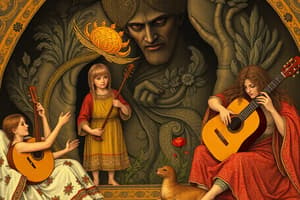Podcast
Questions and Answers
What is the typical range of musicians in an ensemble music performance?
What is the typical range of musicians in an ensemble music performance?
- 15-25
- 20-50
- 2-5
- 3-12 (correct)
Which type of ensemble music is often characterized by a small group of musicians featuring strings, piano, and/or winds?
Which type of ensemble music is often characterized by a small group of musicians featuring strings, piano, and/or winds?
- Orchestral ensemble
- Vocal ensemble
- Jazz ensemble
- Chamber music ensemble (correct)
What is a key characteristic of ensemble music that involves balancing the sound of different instruments or voices?
What is a key characteristic of ensemble music that involves balancing the sound of different instruments or voices?
- Intimacy
- Collaboration
- Flexibility
- Balance (correct)
During which historical period did the development of chamber music and the concerto grosso emerge?
During which historical period did the development of chamber music and the concerto grosso emerge?
Which of the following ensembles is an example of a vocal ensemble?
Which of the following ensembles is an example of a vocal ensemble?
What is a key characteristic of ensemble music that involves a sense of closeness and communication between players?
What is a key characteristic of ensemble music that involves a sense of closeness and communication between players?
Which of the following ensembles is an example of an orchestral ensemble?
Which of the following ensembles is an example of an orchestral ensemble?
During which historical period did the rise of the string quartet and the symphony orchestra occur?
During which historical period did the rise of the string quartet and the symphony orchestra occur?
Flashcards are hidden until you start studying
Study Notes
Ensemble Music
Definition
- Ensemble music refers to a performance of music by a group of musicians, typically featuring a small number of players
- Can range from 2 to 20 or more musicians, but typically 3-12 players
Types of Ensembles
- Chamber music ensembles: small groups of musicians, often featuring strings, piano, and/or winds
- Examples: string quartet, piano trio, woodwind quintet
- Jazz ensembles: small groups of musicians, often featuring saxophones, trumpets, trombones, piano, bass, and drums
- Examples: jazz quartet, jazz quintet, big band
- Orchestral ensembles: large groups of musicians, often featuring strings, woodwinds, brass, and percussion
- Examples: symphony orchestra, chamber orchestra, opera orchestra
- Vocal ensembles: groups of singers, often featuring a cappella or accompanied by instruments
- Examples: choir, vocal quartet, barbershop quartet
Characteristics
- Intimacy: ensemble music often features a sense of closeness and communication between players
- Collaboration: ensemble music requires coordination and cooperation between musicians
- Balance: ensemble music often involves balancing the sound of different instruments or voices
- Flexibility: ensemble music can be adapted to various settings and genres
Historical Development
- Renaissance: emergence of small ensembles, such as the consort and the broken consort
- Baroque: development of chamber music and the concerto grosso
- Classical: rise of the string quartet and the symphony orchestra
- Romantic: expansion of orchestral ensembles and the development of jazz and popular music ensembles
Notable Ensembles
- String Quartets: Amadeus Quartet, Budapest String Quartet, Emerson String Quartet
- Jazz Ensembles: Miles Davis Quintet, John Coltrane Quartet, Dave Brubeck Quartet
- Vocal Ensembles: The Beatles, The Beach Boys, The Manhattan Transfer
Ensemble Music
Definition and Types
- Ensemble music is a performance by a group of musicians, typically 2-20 players, but often 3-12 players
- Chamber music ensembles are small groups featuring strings, piano, and/or winds
Types of Ensembles
- Jazz ensembles feature saxophones, trumpets, trombones, piano, bass, and drums
- Orchestral ensembles are large groups featuring strings, woodwinds, brass, and percussion
- Vocal ensembles are groups of singers, often a cappella or accompanied by instruments
Characteristics
- Intimacy: ensemble music features a sense of closeness and communication between players
- Collaboration: ensemble music requires coordination and cooperation between musicians
- Balance: ensemble music involves balancing the sound of different instruments or voices
- Flexibility: ensemble music can be adapted to various settings and genres
Historical Development
- Renaissance: small ensembles emerged, including the consort and broken consort
- Baroque: chamber music and concerto grosso developed
- Classical: string quartet and symphony orchestra rose to prominence
- Romantic: orchestral ensembles expanded, and jazz and popular music ensembles emerged
Notable Ensembles
- String Quartets: Amadeus Quartet, Budapest String Quartet, Emerson String Quartet
- Jazz Ensembles: Miles Davis Quintet, John Coltrane Quartet, Dave Brubeck Quartet
- Vocal Ensembles: The Beatles, The Beach Boys, The Manhattan Transfer
Studying That Suits You
Use AI to generate personalized quizzes and flashcards to suit your learning preferences.




